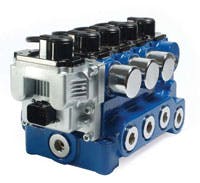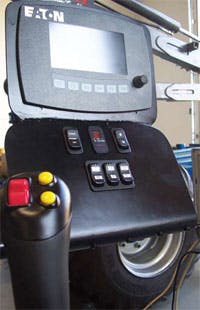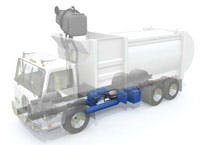By A.J. Smith Eaton Hydraulics Operations Eden Prairie, Minn.
In many ways, the application of electronic controls to mobile equipment mirrors the experience of other markets where a technology is more mature. The issues, as expected, include the application and development of standards, open vs. proprietary software solutions, and various market-specific “packaging” issues.
As with any relatively new technology application, standards for mobile electronic controls are in a state of flux. Fortunately, many existing standards are applicable, and these are being widely adopted. The Controller Area Network (CAN) bus is a good case in point.
CANbus is a frontrunner
Most mobile applications employ a centralized electronic control architecture where a single master controller is used to control all of a machine’s systems. Some of the components are controlled directly via analog or discrete outputs, but a CANbus allows controlled devices to be distributed remotely on the machine.
Each electronic device including the master controller sends control commands to the devices and receives status and other messages via the CANbus. Two major standards are used for CANbus messaging in the mobile application market.
The 29-bit J1939 standard is widely used in North America and also in powertrain applications since it has been adopted as a standard by many engine manufacturers. The 11-bit CANopen standard is more prominent in Europe, but it has also become the de facto standard for general CAN connectivity and is quickly becoming the global standard.
Migrating to a distributed architecture
The availability of a message bus system has allowed mobile equipment to begin migrating to a more distributed architecture based on the use of on-board electronics on individual devices and systems. Each component or sub-system then incorporates some intelligence to handle its own closedloop control. A central controller may still be used in a distributed architecture, but its role is relegated to that of a communication hub and general supervisory control for the overall machine.
In addition to better control at the component level, a distributed architecture facilitates the implementation of a safety-critical system. Obvious and compelling advantages exist for intelligent devices that can act and react on their own over a highly centralized system that has one intelligent device controlling an entire machine.
Open architecture software
Software systems are undergoing a similar evolution. Although some suppliers are still championing proprietary solutions that lock users into their hardware, a strong trend is running in favor of standards-based open architecture solutions.
An open architecture gives the system developer ultimate flexibility for creating a customized application that fits the equipment builder’s need. If the right software is chosen, it can give equipment builders or end-users the flexibility they need to see their designs to fruition while still maintaining the integrity of beneficial proprietary options.
Migration to a distributed system architecture using open architecture software is important for the future because it allows suppliers of devices and systems to further differentiate their product performance via refined on-board electronic controls. It also provides flexibility to use a device on any machine, knowing it will behave in the same manner because the intelligence is in the component.
Eaton’s Ultronics ZTS16 mobile control valve reflects this trend. Taking an open architecture approach and using on-board electronics for its valve control, this system allows users to communicate with and configure the valve via the standard CAN interface. Embedded sensors give it the flexibility to offer not only advanced control, but also diagnostics for easier trouble-shooting.
Programmable electronic control can play a useful role in emissions as well. Existing and developmental steer-by-wire, brake-by-wire, and other function-by-wire technologies address this in several ways:
- Fewer mechanical parts reduce vehicle weight
- Always-on systems can be converted to run-on-demand, saving fuel
- Performance of linked systems, such as engine, transmission, and work circuits, can be coordinated and optimized with intelligent controls to improve overall efficiency, and
- Overall machine behavior and performance can be matched to operator behavior to reduce waste.
Electronic control also is a key enabler for different hybrid technologies, such as Eaton’s Hydraulic Launch Assist, which uses electronics to manage regeneration of power to dramatically improve fuel economy when a vehicle starts and stops frequently. In some cases, load-sensing electrohydraulic systems could even allow smaller engines to be used in mobile equipment by matching power requirements in real-time.
Global application flexibility
The move to electronic controls is often driven by the fact that as the base of mobile equipment throughout the world has grown — especially in fast developing regions like Asia — the population of experienced operators has declined. The wide band of user skills, combined with different operator preferences, has resulted in a requirement for mobile equipment to behave differently based on individual operator skills.
Software-programmable electronic controls solve this problem, allowing equipment behavior and functional capabilities to change at the flick of a switch. This can reduce the time needed to train a new operator, allowing him or her to become productive in less time than ever before.
As part of this trend, operator interfaces are evolving rapidly beyond traditional hydraulic and pneumatic controls to electronic, busbased joysticks, switches, and even touch-panel display screens. Electronic and software controls engineers are now able to bundle the wide array of available components into refined closed-loop systems or complete solutions that are tailored to the exact end-user need.
In some cases, one or two electronic joysticks have been able to replace up to 15 different work-circuit levers and the steering wheel on a mobile machine. This reduction in complexity results in increased operator efficiency through improved ergonomics and greater comfor t while simultaneously improving both control ability and productivity.
Development standards
It is important to have an open architecture that can support a wide range of products in tandem with a standardized approach for application software development that is robust enough to address different applications and user preferences. Eaton’s recently released Control F(x) uses an approach that is becoming more prevalent in mobile applications — the adoption of the IEC 61131-3 programming standard.
Originally published in 1993 and updated in 2003, the IEC 61131-3 standard was the first global standard for industrial control. The standard defines common data structures and programming methodologies to provide multiple engineers and programmers with different skill sets to collaborate on an application program. Practical benefits have resulted in it being adopted for mobile application development as well.
IEC 61131-3 compliant applications are completely scalable and can be updated or enhanced over time by anyone trained in the standard. The ability to save, modify, and re-implement previously developed logic results in rapid control design. Reuse of previously tested and implemented control logic not only increases the efficiency of development, but also the reliability of the end application.
Mobile applications have unique requirements
Although standards and software development issues mirror the experience of other markets, mobile equipment offers some unique packaging challenges for electronic components. Today’s mobile electronics use pulse width modulation and current control outputs to drive valve solenoids with high precision, thereby increasing control and reducing hysteresis. Switches and sensors connected to analog and digital inputs allow for operator and sensor feedback to complete closed-loop controls. These mobile electronics encounter water, dust, and dirt on a consistent basis.
The current baseline standard is an Ingress Protection (IP) 67 rating, which provides a total resistance to dust and to temporary immersion in water. However, many mobile electronics developers are setting their sights on IP 68 and IP 69 K ratings, which will enable their electronics to withstand indefinite submersion up to 10-m deep and withstand high-pressure washes up to 140 bar.
Solutions like these that standardize environmental protection for electronics have helped overcome major hurdles for use in the harsh mobile environment. In addition to dust and water, mobile electronics must also withstand millions of cycles in extreme situations as well as shock and vibration at levels much higher than many other common applications.
Looking forward
Going forward we will see the bus structure on mobile applications evolve rapidly to include more robust Ethernet-based bus systems, such as Ethernet Powerlink and EtherCAT (Ethernet for Control Automation Technology). Both have begun to see use in industrial markets, so they are starting off as industry standards with support from corporate institutions. These bus systems are capable of more bandwidth, faster message transfer, and more precise message organization. This makes them ideal for tomorrow’s increasingly complex mobile applications requiring unprecedented control precision.
The benefits of the coupling of electronic controls and sophisticated hydraulic systems in mobile applications are obvious and compelling. We will certainly see companies at all levels of the mobile equipment value chain enhance their capabilities with technical personnel with the combination of electronic and software programming skills required for component development and system integration. Mobile hydraulic systems are here to stay, but going forward they will have to leverage electronic controls to operate at the top of their game.




